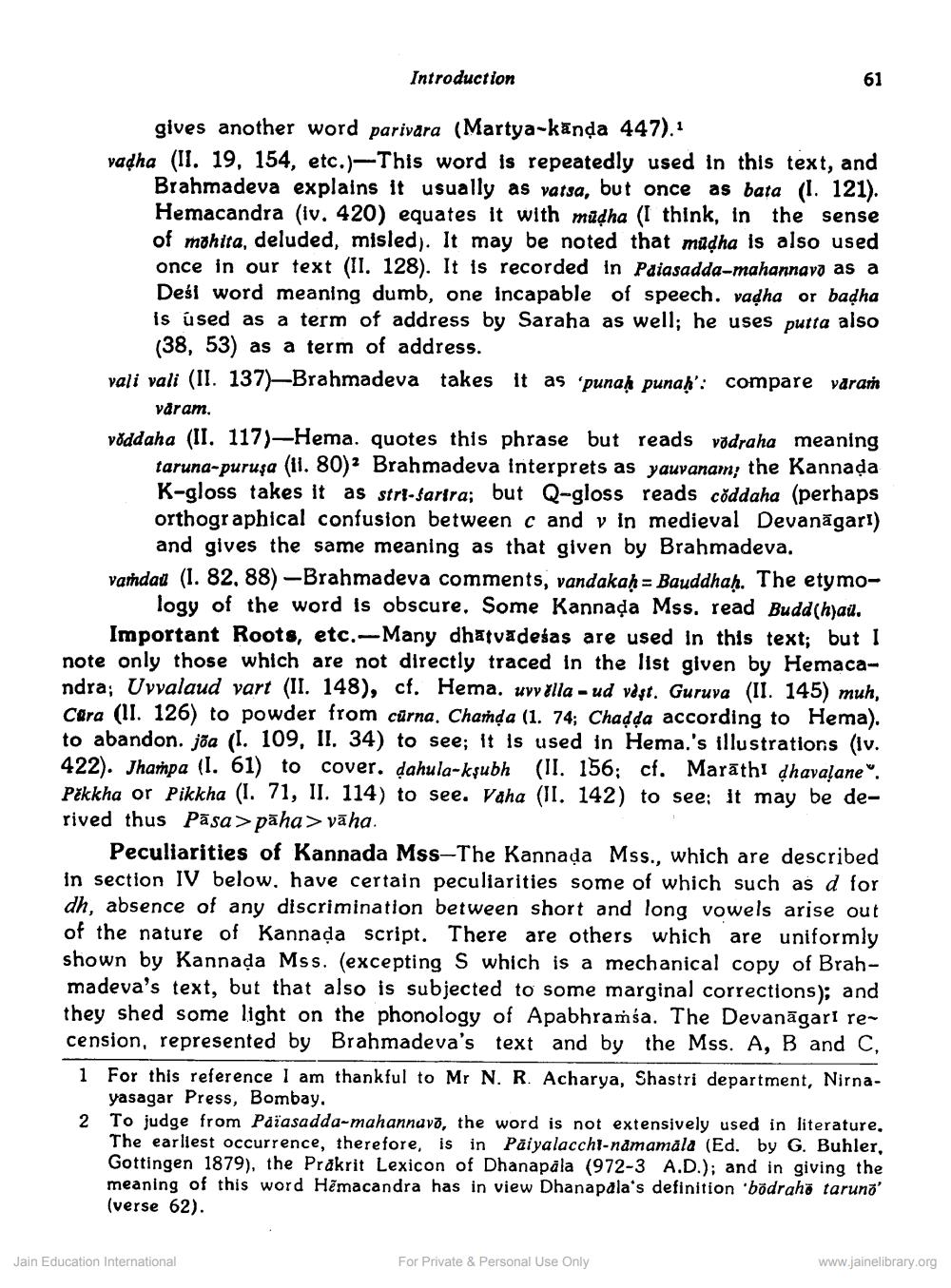________________
Introduction
gives another word parivara (Martya-kanda 447).vadha (II. 19, 154, etc.)-This word is repeatedly used in this text, and
ahmadeva explains It usually as vatsa, but once as bata (I. 121). Hemacandra (iv, 420) equates it with müdha (I think, in the sense of möhita, deluded, misled). It may be noted that müdha is also used once in our text (11. 128). It is recorded in Paiasadda-mahannavo as a Deśl word meaning dumb, one incapable of speech. vadha or badha is used as a term of address by Saraha as well; he uses putta also
(38, 53) as a term of address. vali vali (II. 137)—Brahmadeva takes it as 'punah punah': compare varan
väram. voddaha (II. 117)-Hema. quotes this phrase but reads võdraha meaning
taruna-puruşa (11. 80)2 Brahmadeva interprets as yauvanam, the Kannada K-gloss takes it as stri-sarira; but Q-gloss reads coddaha (perhaps orthographical confusion between c and v in medieval Devanagari)
and gives the same meaning as that given by Brahmadeva. vandat (1. 82, 88) -Brahmadeva comments, vandakah = Bauddhah. The etymo
logy of the word is obscure. Some Kannada Mss. read Budd(hai. Important Roots, etc.-Many dhatvadesas are used in this text; but I note only those which are not directly traced in the list given by Hemacandra; Uvvalaud vart (II. 148), cf. Hema. uvyšlla - ud vest. Guruva (II. 145) muh, Cara (II. 126) to powder from cũrna. Chanda (1. 74; Chadda according to Hema). to abandon. jõa (I. 109, II, 34) to see; it is used in Hema.'s illustrations (iv.
Jhampa (l. 61) to cover. dahula-kşubh (II. 156; cf. Marāthi dhavalane Pžkkha or Pikkha (I. 71, II. 114) to see. Vaha (II. 142) to see: it may be derived thus Pāsa > pāha > vāha.
Peculiarities of Kannada Mss-The Kannada Mss., which are described in section IV below, have certain peculiarities some of which such as d for dh, absence of any discrimination between short and long vowels arise out of the nature of Kannada script. There are others which are uniformly shown by Kannada Mss. (excepting S which is a mechanical copy of Brahmadeva's text, but that also is subjected to some marginal corrections); and they shed some light on the phonology of Apabhramśa. The Devanāgari recension, represented by Brahmadeva's text and by the Mss. A, B and C, 1 For this reference I am thankful to Mr N. R. Acharya, Shastri department, Nirna
yasagar Press, Bombay. 2 To judge from Païasadda-mahannavo, the word is not extensively used in literature,
The earliest occurrence, therefore, is in Päiyalacchi-namamala (Ed. by G. Buhler, Gottingen 1879), the Prakrit Lexicon of Dhanapala (972-3 A.D.); and in giving the meaning of this word Hēmacandra has in view Dhanapala's definition bödraho taruno' (verse 62).
Jain Education International
For Private & Personal Use Only
www.jainelibrary.org




